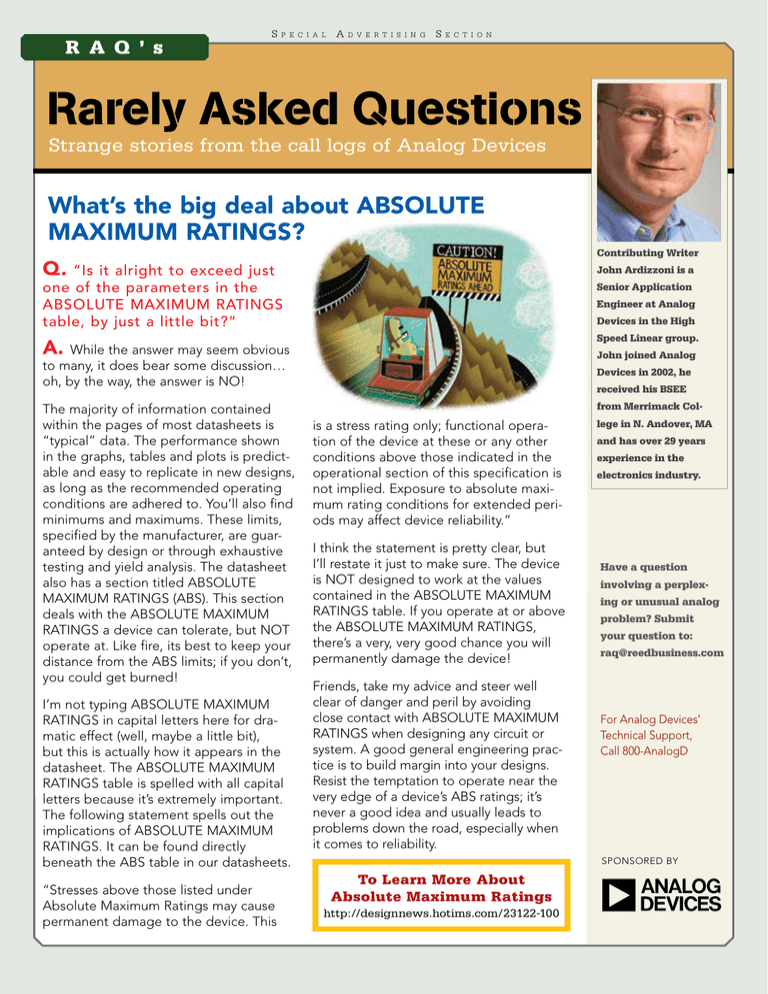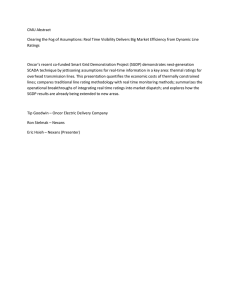Rarely Asked Questions R A Q ’ s Q.
advertisement

R A Q ’ s S p e c i a l A d v e r t i s i n g S e c t i o n Rarely Asked Questions Strange stories from the call logs of Analog Devices What’s the big deal about ABSOLUTE MAXIMUM RATINGS? Contributing Writer Q. “Is it alright to exceed just one of the parameters in the ABSOLUTE MAXIMUM RATINGS table, by just a little bit?” John Ardizzoni is a A. Speed Linear group. Senior Application Engineer at Analog Devices in the High While the answer may seem obvious to many, it does bear some discussion… oh, by the way, the answer is NO! The majority of information contained within the pages of most datasheets is “typical” data. The performance shown in the graphs, tables and plots is predictable and easy to replicate in new designs, as long as the recommended operating conditions are adhered to. You’ll also find minimums and maximums. These limits, specified by the manufacturer, are guaranteed by design or through exhaustive testing and yield analysis. The datasheet also has a section titled ABSOLUTE MAXIMUM RATINGS (ABS). This section deals with the ABSOLUTE MAXIMUM RATINGS a device can tolerate, but NOT operate at. Like fire, its best to keep your distance from the ABS limits; if you don’t, you could get burned! I’m not typing ABSOLUTE MAXIMUM RATINGS in capital letters here for dramatic effect (well, maybe a little bit), but this is actually how it appears in the datasheet. The ABSOLUTE MAXIMUM RATINGS table is spelled with all capital letters because it’s extremely important. The following statement spells out the implications of ABSOLUTE MAXIMUM RATINGS. It can be found directly beneath the ABS table in our datasheets. “Stresses above those listed under Absolute Maximum Ratings may cause permanent damage to the device. This John joined Analog Devices in 2002, he received his BSEE from Merrimack Col- is a stress rating only; functional operation of the device at these or any other conditions above those indicated in the operational section of this specification is not implied. Exposure to absolute maximum rating conditions for extended periods may affect device reliability.” I think the statement is pretty clear, but I’ll restate it just to make sure. The device is NOT designed to work at the values contained in the ABSOLUTE MAXIMUM RATINGS table. If you operate at or above the ABSOLUTE MAXIMUM RATINGS, there’s a very, very good chance you will permanently damage the device! Friends, take my advice and steer well clear of danger and peril by avoiding close contact with ABSOLUTE MAXIMUM RATINGS when designing any circuit or system. A good general engineering practice is to build margin into your designs. Resist the temptation to operate near the very edge of a device’s ABS ratings; it’s never a good idea and usually leads to problems down the road, especially when it comes to reliability. lege in N. Andover, MA and has over 29 years experience in the electronics industry. Have a question involving a perplexing or unusual analog problem? Submit your question to: raq@reedbusiness.com For Analog Devices’ Technical Support, Call 800-AnalogD SPONSORED BY To Learn More About Absolute Maximum Ratings http://designnews.hotims.com/23122-100






